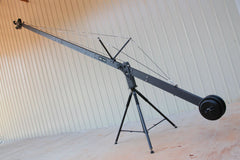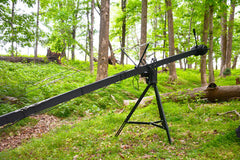About this shoot
Before the TigerTilt Motorized Pan Head was released, I wanted to create a beautiful video composition that clearly conveyed its abilities. They are only amplified when mounted to our largest crane, the Taurus XL. I decided on a nature setting, deep in the woods of the Southeast US. The tall trees and low forest ground covering would provide perfect environment for some dynamic and compound movements.


As the camera tracks up a mature 100ft hardwood tree, you can really feel the extent of the movement. It's the type of view you'd expect to regularly see if you were a squirrel.
Sweeping motions along the ground are equally impressive as you gain ground quickly, large trees and grass speeding by. It's as if you are flying beneath the trees.
For this shoot, I wanted to have the viewers dance with the trees and the elements of nature that we often take for granted as just that, static elements in the background. It's very humbling and pleasing to be among these patient giants, and have them as your most agreeable subjects ever.

This was an extremely enjoyable shoot, and I wanted to keep filming even as it was sunlight was fading. The problem was that the overall weight of all of my equipment, easily surpassing 200 pounds, was so much that I had to make multiple trips through a long wooded path, pulling a wagon. I ended up leaving the crane out in the woods, returning to shoot the next day. Of course it was covered in spiderwebs, and other indicators that it had an exciting night alone in the woods. I reviewed the footage that evening and was able to finish getting the last shots the next day.
Equipment
The main support in this short video is the Taurus XL camera crane, our longest and beefiest model at a full 20 feet long. It's modular so can also be used at 12 or 16 feet. For this shoot I wanted the maximum expression of depth, so I used it at the 20 foot configuration throughout.
The motorized pan and tilt head, the TigerTilt, is our first unit of this kind. The design is simple and effective. Two motors turn the camera cradle vertically and horizontally. It's all controlled by a pressure sensitive joystick remote that can even compound the movements. It supports up to 8 pounds, perfect for professional DSLRs. I brought our 12V battery adapter plate and ran the TigerTilt on a Canon LPE6 battery; convenient because I'm still using my old faithful Mark 5DII.


Also making its first appearance is our super heavy duty tripod, the Taurus Tripod. It was specifically designed to support the weight of the Taurus XL jib with a maximum capacity of 300 pounds. The legs are adjustable, making it a great support when on uneven terrain in the woods.


Additionally, I used the Iris Pro monitor, a 7 inch HD compatible LCD video monitor. Since I'm so far away from civilization, I brought along another of our 12V battery packs and it's being powered by a Canon BP915 which will last for hours. When shooting with a camera crane or jib, a monitor is truly indispensable. And because I'm also using a pan and tilt head, it's necessary to track my shots. Often, I work through the monitor only while filming. The overcast day allowed me to shoot without a monitor hood, but I would normally use one when outdoors.
It's also important to note how I secured the cables to the crane body using velcro strips. This helps in various ways; keeping anything from getting tangled during movements or preventing nasty little instances of ripped out HDMI connections. Just don't be too over zealous in your strap use as you could actually cause a ripped out HDMI connection if you don't allow enough slack.
Methods
When shooting a pan with a camera crane, elements in the foreground pass by quickly as those in the background enter and exit frame slowly. This happens too when making motions on any other axis. You can rotate on a fixed point as with a camera crane or making a dolly shot that travels along a plane. It sounds so obvious, but it's not always as obvious to be aware of how changing perspectives affect the emotions of the viewer, and how to best use them to elicit the desired emotion. A quickly moving camera through a plane with many foreground objects would likely create a feeling of tension, desire to escape, claustrophobia perhaps. On the other hand, a crane shot on the beach, traveling slowly across the sand with no objects in the foreground could evoke a feeling of peace and relief.
Side note: You can create the reverse effect of faster moving foreground objects when a crane shot is combined with a motorized head. You'll see a couple of these in the video where the crane is panning the camera one way, while the pan/tilt head is panning the opposite. This keeps the focus on the foreground subject, while the background quickly changes.
I tried to create a sense of excitement, without too much intensity. Movements ease in and out and I try to let the shots slow down before cutting. This is very important when operating a crane, so always ease in and ease out. As if you were driving a car, lightly apply pressure to the gas and do the same as you come to a stop. Your passengers (audience) will be much more pleased when you're in the driver's seat. If your goal is to create a fast paced and exciting video, you can always cut those beginning and ending shots to maintain the same speed through attached clips.
The key to smooth shots is being gentle while maintaining control. Often when I'm operating a crane, I feel as though I'm doing Tai Chi, or auditioning as a ninja. You may need to exert force while maintaining a slow movement of your arms. It's quite fun to practice and you'll get better with every shoot. If you find that your shots are wobbly or jerky, don't get frustrated. Be patient, practice and remember how well you operated a car when you were 15.
Please comment below if you have any good tips for filming while in motion. We'd love to hear!
-Jonathan



